

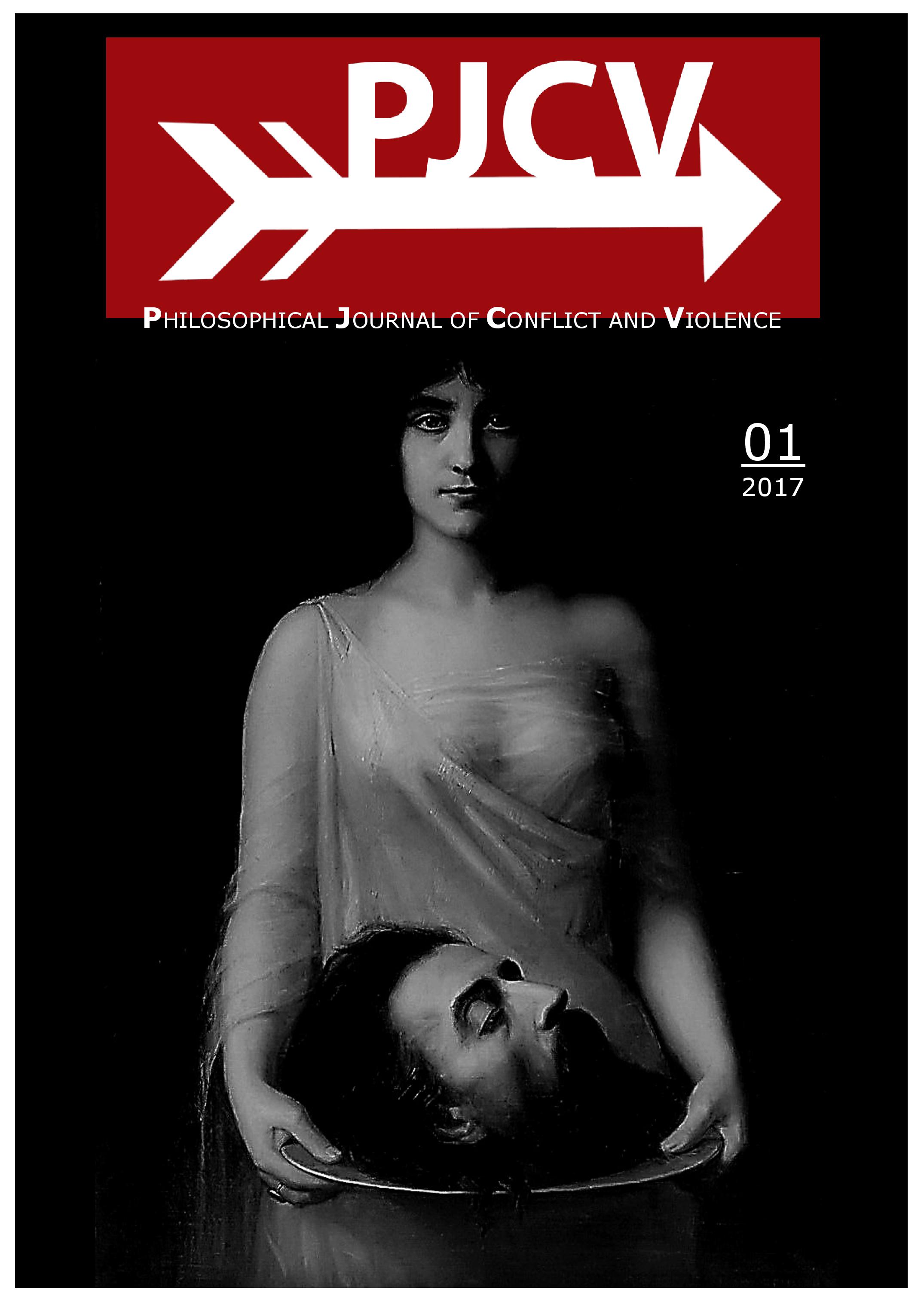
The Philosophical Journal of Conflict and Violence (PJCV) is devoted to fostering discussion at the interface of philosophy, psychiatry, psychology, anthropology, and political theory. The journal welcomes original articles providing philosophical insights about topics such as conflict, war, crime, and aggression. The PJCV encompasses contributions from the history of philosophy to more interdisciplinary studies. Specifically, the main ambition of the journal is to form a database on the conceptual, metaphysical, ethical, and epistemological issues related to past and contemporary phenomena of violence.
The PJCV is double-blind peer-reviewed and published bi-annually in May and December. In order to avoid thematic fuzziness, each issue will begin with a focus section featuring contributions addressing a specific topic. The subjects are announced in advance in each issue’s call for papers. Besides, the open section of the journal provides a place for general contributions to conflict and violence. The editors encourage critical discussions involving a wide range of disciplines. The requirements are clarity of expression and rigorous argumentation.
PJCV welcomes submissions throughout the year on subjects related to the scope of the journal (non-binding to special issues): philosophy, psychiatry, psychology, anthropology, political theory, conflict, war, crime, aggression, etc.
More...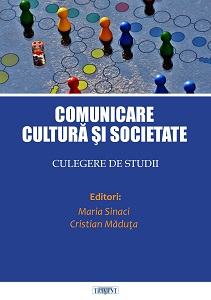
Keywords: culture; society; philosophy; Bühler-Habermas; persuasion; mass media; globalization; ethics;tradition; education; pedagogy; Kafka; David Lodge; modernism; post-modernism; Facebook; Camil Petrescu; Haiti; university; academia; identity; history;elderly
This volume is a collection of studies written by academics from the “Vasile Goldis” Western University of Arad, the West University of Timisoara, the “Lucian Blaga” University of Sibiu and the University of Novi Sad. Most of these studies were presented at the annual conference organized by the “Vasile Goldis” Western University of Arad with the occasion of the annual event known as the Academic Days of Arad.
More...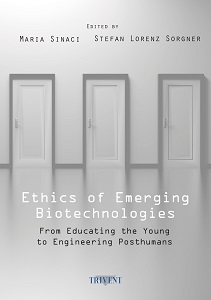
Pastor Fritz Jahr used the term bioethics as early as 1927. It was not until the early 1970s that the term was rediscovered in the United States. Since then, the relevance of this emergent academic field of studies has permanently been growing, as the age of biotechnological and medical innovations has only just begun. Enormous progress can be expected in various areas relevant to bioethical discourses in the coming decades and centuries. In the past years, the invention of CRISPR/Cas9 has radically changed the possibilities concerning genetic modifications, even germline modifications have turned into a practical option. These developments need to be investigated by academics from various disciplines, which is the reason why the conference series on Bioethics in the New Age of Science was initialized. The present volume consists in selected papers from the first International Conference on Bioethics in the New Age of Science, which took place on the 4th and 5th of May 2017 at the “Vasile Goldis” West University of Arad, Romania.
More...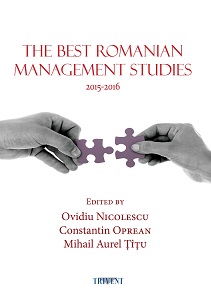
Keywords: Romania;Management; Planning;KAIZEN; Crisis;Human resource management;Tourism;E-Waste management;
Modern management is represented by global management with a modern interdisciplinary approach which allows no ambiguities. Today, there is a need of managers who are capable to appreciate the values of society based on knowledge. The solution is quality management based on clear procedures to recognize moral and professional competences. The type of management practiced in teams brings a plus of professional value and offers a sustainable development. Competent and well-trained professionals can take this solution to success on both short and long term. This book brings together management studies worthy of following. Quality represents the road to success, while performance and intellectual property is the path to sustainable competitive advantage.
More...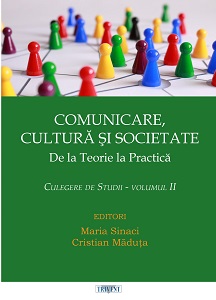
Keywords: Communication; Ethics; Language; Multicultural; Intercultural; Philosophy;Society;
More...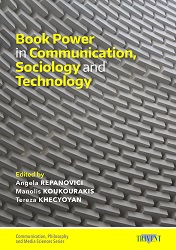
Keywords: Book; Library; Library science; Communication; Sociology; Technology
A book may be seen as a symbol, a product, or even a miracle. It used to represent (and still represents) the most important element of the spiritual connection between generations, between different professions, between education and multicultural systems. The book is the oldest economic model developed by libraries, an investment in a product which gives benefit to as many people as possible. In 2012, The Library of Congress (Washington, D.C., U.S.A.) had the initiative of organizing an annual meeting which would disseminate the vision of library leaders on the importance of the book. The meeting would gather all the categories involved in the book industry: writers, publishers, editors, professors, librarians. The goal was to create a platform for discussions on how to promote the book as a crucial element for culture and education enhancement. The power of information and its dissemination was discussed within the first edition, while keeping the book as a central element in all debates. After this first edition, the Summit of the book was organized yearly in different locations throughout the world: Singapore (2013), France (2014), Egypt (2015) and Ireland (2016). The event had a powerful international impact and in 2017 the 6th summit was hosted in Brasov (Romania) at the “Transilvania” University. This volume is the collection of the most valuable contributions to the 6th Summit of the Book where experts presented their best practices and expertise in the history and technology of the book, knowledge support, and book dissemination.
More...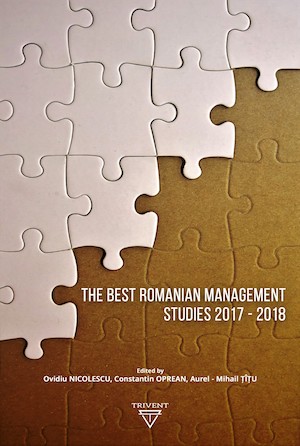
Keywords: management; marketing; KAIZEN; Knowledge management; Knowledge management enabler; developing country; academic spin-off; risk management; Industry 4.0;
The only inexhaustible resource whose development trend is positive is knowledge. This extraordinary capital, which represents the legacy of the effort and creative work of both the past and present generations, has made specialists from all over the world unanimously agree that we live in a knowledge-based society. Such a society can only be built with knowledge-based organizations. Global management must have a modern approach with no ambiguity. The correct solution for this is a management based on applicable procedures for recognizing people’s moral and professional competences. Competent and well-trained people are the only ones who can provide the right solution for the success of the organization. This volume collects engaging management studies from various fields of management.
More...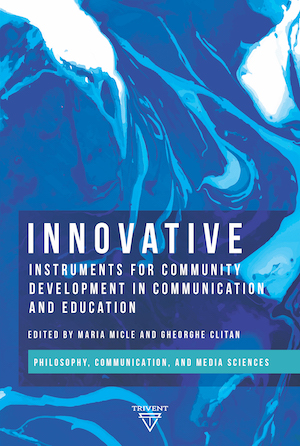
Keywords: Communication; Philosophy; Mass-Media; Poiltics; Philosophical Counselling; cultural identity; public learning; library science; electoral campaigns; manipulation; applied philosophy
The multiple facets of this volume belong to five large themes. The first theme, that of persuasion and manipulation, is studied here through electoral campaigns (i.e., mental filters used in voting manipulation, the mechanisms of vote mobilisation, manipulation and storytelling models). The institutionalization of education represents the second theme, approached here through specific interdisciplinary instruments: the intersection of higher education with public learning, the answers of the knowledge society to the issues of contemporary work problems, the institutional relationships used to solve educational problems specific to childhood and adolescence, as well as the role of media competencies in professional development. The third theme is related to the inheritance and transmission of cultural identity, instrumentalized through issues such as: the duty of intergenerational justice with regard to cultural heritage, education and vocational training in library science, the social inclusion role of public and digital libraries. The collective and cultural identity of communities represents the fourth large theme, being approached through a triple perspective: the philosophical background of restoring the political dignity of communities, the communication space as a point of a needle towards the community space, and the communicational issue of the European capital of culture programmes. Lastly, the fifth theme belongs to practical and applied philosophy, specifically philosophical counselling, debating issues such as: the identification of the communicational background for this type of counselling, the secular approach to the problem of evil from a philosophical counselling perspective, the discussion of Platon’s attitude towards suicide and of frank speech in the Epicurean school, the socio-anthropological perspective of immortality, as well as the formal approach of the relationship between real and imaginary.
More...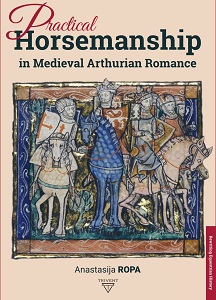
Keywords: medieval horsemanship; medieval history; Geoffrey Chaucer; Canterbury Tales; Queste del Saint Graal; Arthurian Romance; Arthuriana;Knight;
The figure of a knight on horseback is the emblem of medieval chivalry. Much has been written on the ideology and practicalities of knighthood as portrayed in medieval romance, especially Arthurian romance, and it is surprising that so little attention was hitherto granted to the knight’s closest companion, the horse. This study examines the horse as a social indicator, as the knight’s animal alter ego in his spiritual peregrinations and earthly adventures, the ups and downs of chivalric adventure, as well as the relations between the lady and her palfrey in romance. Both medieval authors and their audiences knew more about the symbolism and practice of horsemanship than most readers do today. By providing the background to the descriptions of horses and horsemanship in Arthurian romance, this study deepens the readers’ appreciation of these texts. At the same time, critical reading of romance supplies information about the ideology and daily practice of horsemanship in the Middle Ages that is otherwise impossible to obtain from other sources, be it archaeology, chronicles or administrative documentation.
More...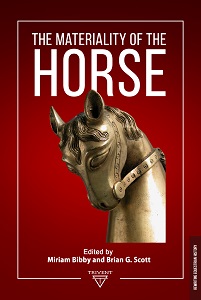
Keywords: equine history; middle ages; material culture; horse-human relationship; Islam; indigenous cultures; South America
Inspired by our age-old fascination with equids, Materiality of the Horse brings the latest academic research in equine history to a wider readership. Themes examined within the book by specialist contributors include explorations of material culture relating to horses and what this discloses about the horse-human relationship; fresh observations on significant medieval horse-related texts from Europe and the Islamic world; and revealing insights into the effect of the introduction of horses into indigenous cultures in South America. Thought-provoking and original, Materiality of the Horse is the second volume in Trivent Publishing’s innovative “Rewriting Equestrian History” series.
More...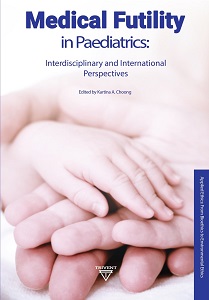
Keywords: Law; Medicine; Medical Ethics; Theology; paediatrics; paediatric palliative care; Health Policy and Management; English Literature; Nursing and History; Charlie Gard; Alfie Evans
This book addresses the issues and challenges raised by the high-profile cases of Charlie Gard and Alfie Evans. The individual chapters, which complement one other, were written by scholars with expertise in Law, Medicine, Medical Ethics, Theology, Health Policy and Management, English Literature, Nursing and History, from the UK, Australia, Canada, the Czech Republic, France, Germany, India, Spain, Turkey and the USA. The following are among the key questions explored in the book. Is the courtroom an appropriate forum for resolving conflicts relating to medical futility in paediatrics? If so, should parental rights be protected by confining judicial powers only to cases where there is a risk of significant harm to the infant; or should the “best interests” test continue to be recognised as the “gold standard” for paediatric cases? If not, should mediation be used instead, but how well would this alternative method of dispute resolution work for medical futility conflicts? Further, should social media be deployed to garner support, and should outsiders who are not fully acquainted with the medical facts refrain from intervening? And, how are comparable situations likely to be managed in different countries? What lessons can be learned from them as well as from religious perspectives?
More...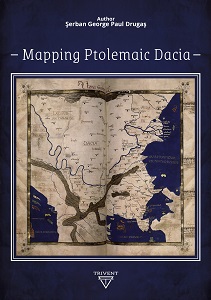
Keywords: Ptomely; mapping; Antiquity; Late antiquity; Dacia; Romania; universal map
This volume is a contribution to the decipherment of Ptolemy’s universal map, with focus on the territory known as Dacia. The information provided by Ptolemy was translated into modern data considering local features and complying with certain general principles. The difficulty of this task consisted in the way the ancient manuscripts transmitted the original location coordinates, as well as in the way Ptolemy patched together information from ancient itineraries and other sources. The author of this volume conceived a general formula for mapping Dacia based on the information found in the two oldest sources he used. Furthermore, he determined local patterns with the help of the other sources – therefore, defining locations resulted in a better determination of the surrounding relative positions. This information, as well as the correlation of the Ptolemaic locations with archaeological findings, provides an increased recognition of Ptolemaic Dacia, while also contributing to exposing the Ptolemaic universal map.
More...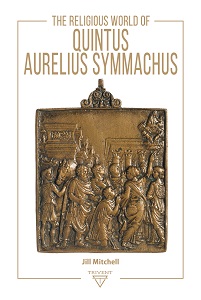
Keywords: Rome; Roman Empire; pagan; Late Antiquity; Roman aristocracy; Altar of Victory Dispute; Christianity; polytheism; religion;
“The Religious World of Quintus Aurelius Symmachus” examines the religious life of one of the last pagan senators of Rome, dates c. 340-402, who lived in a tumultuous time during the Late Antique period of the Roman Empire, dying just a few years before the Western Empire began to break up. Symmachus could not have imagined the political reality developing so soon after his death, so he is important as a late example of the old Roman Western aristocracy, as well as one of the last pagans of Rome. He was regarded as the foremost orator of his time and was a prolific letter-writer who had correspondents in high places and throughout the Empire. He also filled the posts of Urban Prefect of Rome and Consul - and was the opponent of Bishop Ambrose of Milan during the so-called 384 CE “Altar of Victory Dispute,” which was one episode of many leading to the “ triumph” of Christianity over traditional Roman polytheism. Symmachus’ cache of 900 private letters and his official despatches while Urban Prefect have provided the raw material for this book.
More...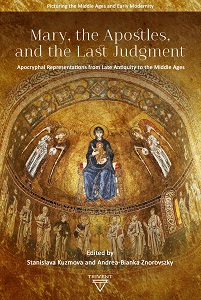
Keywords: apocryphal writings; Virgin Mary; apostles; Last Judgement; middle ages; Christianity; history of religion; theology; art history; manuscript studies;
This volume presents a timely contribution to the growing body of scholarship on the apocryphal writings and their reception in the Middle Ages, especially in connection with visual representation. It aims to bridge what often remains disconnected, the visual art and the written text, the early Christian roots and medieval reception, the East and the West, as well as methodologies of various disciplines. The studies in this volume firstly investigate issues related to the Virgin Mary, and through them, also the status, function, and identity of women. Mary and the female element thus represent significant models and/or background figures in fields pertaining to theology, religious studies, textual studies, manuscript studies, and art history in a trans-disciplinary perspective. Secondly, the studies focus on the apostles and the Last Judgment, their visual representations and the use of apocryphal sources. The volume is divided in two parts according to two major topics: Part I dealing with Mary in the Apocrypha, and Part II focusing on the Apostles and the Last Judgment.
More...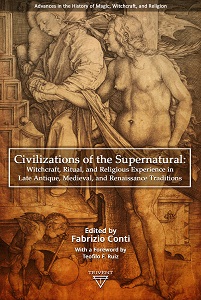
Keywords: Witchcraft; ritual; religion; theology; magic; supernatural; medieval history; renaissance; antiquity; pagan magic; superstition; Christianity; graphophagy; Agrippa; Shakespeare; Bible
Civilizations of the Supernatural: Witchcraft, Ritual, and Religious Experience in Late Antique, Medieval, and Renaissance Traditions brings together thirteen scholars of late-antique, medieval, and renaissance traditions who discuss magic, religious experience, ritual, and witch-beliefs with the aim of reflecting on the relationship between man and the supernatural. The content of the volume is intriguingly diverse and includes late antique traditions covering erotic love magic, Hellenistic-Egyptian astrology, apotropaic rituals, early Christian amulets, and astrological amulets; medieval traditions focusing on the relationships between magic and disbelief, pagan magic and Christian culture, as well as witchcraft and magic in Britain, Scandinavian sympathetic graphophagy, superstition in sermon literature; and finally Renaissance traditions revolving around Agrippan magic, witchcraft in Shakespeare’s Macbeth, and a Biblical toponym related to the Friulan Benandanti’s visionary experiences. These varied topics reflect the multifaceted ways through which men aimed to establish relationships with the supernatural in diverse cultural traditions, and for different purposes, between Late Antiquity and the Renaissance. These ways eventually contributed to shaping the civilizations of the supernatural or those peculiar patterns which helped men look at themselves through the mirror of their own amazement of being in this world.
More...